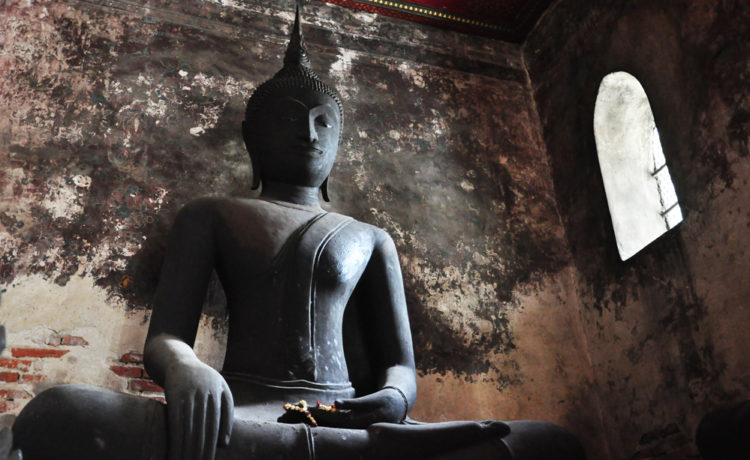
Meditate!
By Nikki Costello, August, 2008
Like Space,
Meditate without center or limit!
Like the sun and moon,
Meditate in brightness and clarity!
Like the mountains,
Meditate, unmoving and unshakeable!
Like the ocean,
Meditate, deep and unfathomable!
– Milarepa
I am sitting in a room with many others and we are meditating. At the end of this hour-long session, chimes ring to call us gently back from this space of silent absorption. Our teacher observes us as we all open our eyes and start to move. At first she says nothing. Then moments later she shares her observations. As I listen, I realize that she has seen me. She has seen my mind. She has seen my restlessness, my eyes wandering to look around the room. She has seen my need to be done with the “silent time”. She has seen my impulse and eagerness to move, to stand up and start talking about what has just happened. How absorbed could I have been if what my teacher noticed about me the moment I opened my eyes was true? I had been seen… Caught in the act of making my meditation practice like the other activities I do, and then cross off a ‘list’ as they are accomplished. At first, I became flush with embarrassment. Then, I wanted a do over so I could get it right the next time. And, finally, I simply smiled with gratitude that I had been seen with love, and because of this I had an opportunity to learn and be more Self-aware.
The goal of meditation is to take us deeply into the experience of the Self. Each time we sit to meditate we are creating a pathway that leads us toward our goal; and, eventually, we are able to live in a continuous awareness of the Self. This kind of Self-awareness is a gradual process of discovery, exploration and practice.
But, “What is the Self?” Spiritual traditions refer to the Self in various ways, yet each one is pointing to the same thing. Each tradition uses words, analogies, metaphors or images to describe an experience that has the power to transform our perception of who we are from one that is small and separate, to one that is expansive and divine, all-encompassing and pervasive. We may understand Self-awareness to be getting to know one’s self, our habits, behaviors, tendencies etc. And this is true in understanding our personality. Yet the Self with a capital “S” that is spoken about in the scriptures of yoga is referring to our essence, our light, our natural state of being, pure consciousness.
The experience of the Self is not really so elusive. If we take a moment to reflect now, chances are the experience of the Self is very close to us. The Self wants to be known, to be seen, and finds ways to get our attention. One of the most common ways is with the help of nature. When nature naturally expresses her beauty in colors, textures, smells, sounds and tastes, she can catch us by surprise and for a moment we stop, breathe and take it in. We are suspended in time, totally present and absorbed. Has the sound of the ocean ever drawn you into its rhythm and breath? Has the color of the evening sky quieted your busy mind? Do the birds whisper in such a way that you can hear your own voice more clearly? Does summer fruit taste so sweet that you want to savor each refreshing bite?
When nature seduces our five senses, we can spontaneously experience the Self. And for those precious moments our thoughts dissolve, we forget what we are ‘supposed’ to be doing, and instead we savor the moment. Whenever we are fully engaged, absorbed in something we love, the Self is also present, and draws us into our own silence. This silence is not just the absence of speaking, but a silence that penetrates beyond the level of words and thoughts. The silence that lives below the surface of the mind. The silence that has nothing to do with speaking, or even with thinking, and everything to do with being.
So if we want to understand the very purpose of yoga we can begin to contemplate those spontaneous experiences of the Self that we all have from time to time, and through our practice we can learn how to invoke them continuously.
As I contemplated the experience I had with my teacher, I began to incorporate a change and added a new step in my practice of meditation that would support my intention to stay with the Self: A pause. A long pause, unfilled space, stillness in the body as I gradually emerged and opened my eyes. Even if my meditation practice only lasted 5 minutes with closed eyes, I sat for another 2 minutes in the same posture of receptivity as I opened my eyes. As I started to do this, I realized that on some level I was really uncomfortable with silence, with empty spaces or with what appeared to be moments of non-doing. This open-eyed reflection allowed me to transition and fully acknowledge and honor the power meditation had on my mind and body. And in my heart I was able to savor what I had received and to stay in relationship with the Self.
Just as our need to stay connected after positive experiences with others is a way to extend a feeling of love and fulfillment, pausing after meditation is a way to deepen and maintain the feeling of connection that the practice of meditation provides. Have you ever had a great meeting with a friend or a lover, and just after parting you call or text them to say again, “that was really great, thank you”? And perhaps, in that additional acknowledgment, a bigger space of love opens up inside. This is what we need to practice doing with ourselves, in silence, after meditation, or after savasana in a yoga class.
As a teacher of yoga, I recognize a similar tendency in students to resist those last moments of stillness–especially at a time when activity, communication, connection and accessibility have taken on a new level of importance and immediacy. We attend our yoga class, move the body vigorously, challenge ourselves mentally, emotionally and physically and when all that is done…we run. Of course, not literally, but within seconds we get reconnected to ‘the world’. Turn everything on and go.
Wait! Stay silent. Stay connected to the Self and to the experience of your own heart.
Meditate!
With love,
Nikki Costello

